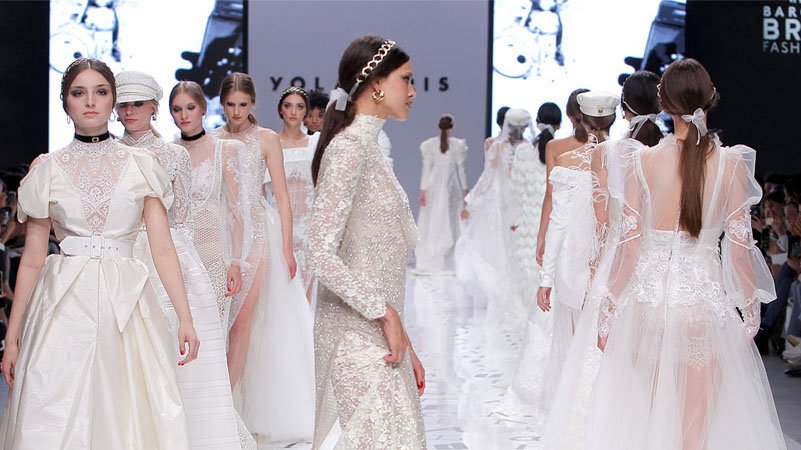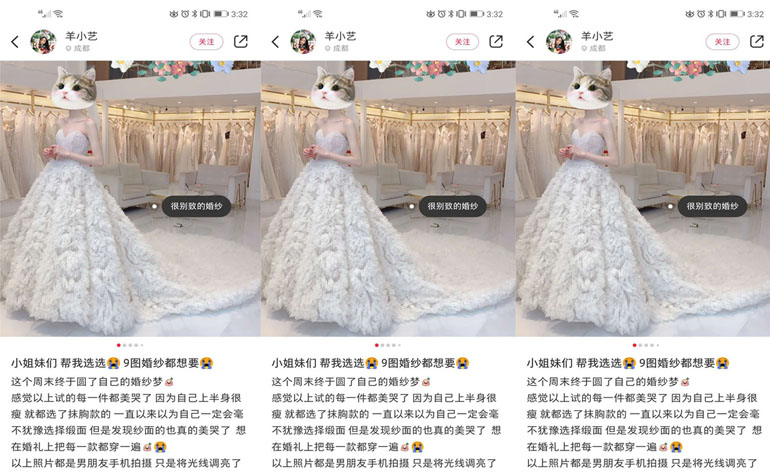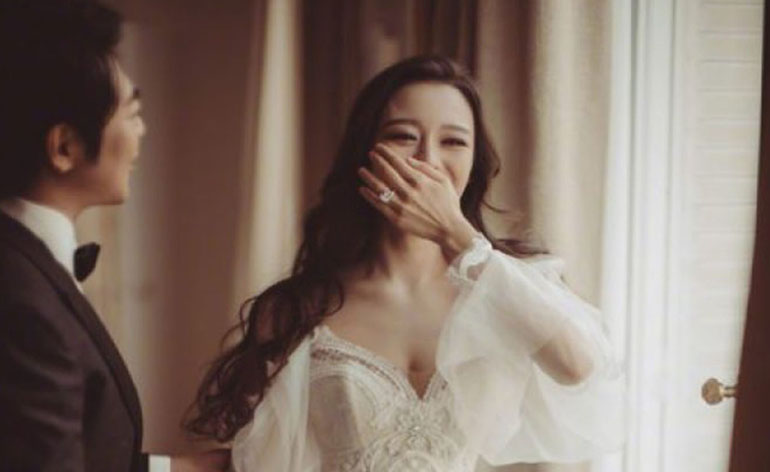
As the value of the wedding industry in China continues to grow exponentially and international wedding dressmakers fight to get a share of the pie, what factors should they be taking into consideration?
In 2019, 9.47 million couples tied the knot in China – making it the first time the nation’s marriage figures slid below the 10 million mark in the past decade. The number of couples saying “I do” in China has been falling since 2013, when the marriage rate stood at a modest 9.9 per 1,000 people. With the younger generation increasingly concerned about rising costs of living and the impact of marriage on personal finances, this trend shows no signs of reversing.
But while the number of couples choosing to wed are falling, those who choose to get hitched are spending larger sums of money on their nuptials. Studies have reflected that the value of the wedding industry in China has been growing steadily over the years, hitting around 2.27 trillion RMB last year. This number is expected to balloon to a whopping 3.36 trillion RMB by 2021.
As the younger Chinese generation becomes increasingly exposed to the rest of the world, their expectations rise and tastes become more discerning. This has led to a proliferation of the bridal industry in the world’s most populous nation. While their parents might have been contented with rented gowns and a simple celebration, today’s couples aspire for much more.
Deep Pockets, Huge Budgets
Chinese brides are a very different breed from their Western counterparts. Taste and preferences aside, the cultural climate they grew up in has largely influenced their consumption habits. Unlike in Western societies where the bride’s family traditional foots the bill for the wedding, the groom’s family is expected to pick up the tab in China. This expectation is so deeply ingrained in society (especially in urbanised, tier one cities) that once a son is born, the family starts planning and saving up for his potential marriage – which would require him to provide a house and car for his bride on top of all wedding-related costs.
This is further exacerbated by the One Child Policy in China, which was only reformed in 2016. Many young couples of marriageable age now are products of the old policy, and have grown up being thoroughly pampered and financially supported by their families. Naturally, their weddings are no exception – parents spare no expense on this occasion.
Consequently, this sense of excess and enablement influences the choices made by brides in terms of wedding gowns as well. “Europeans want practical and casual dresses. But Chinese prefer more spectacular couture dresses,” says Yolanda Pérez – the designer behind Yolancris, a luxury bridal and evening dress brand hailing from Barcelona. Her creations are stocked at 15 stores around China, including seven Top Bridal boutiques – the country’s leading bridal chain carrying nearly 50 top brands from Europe to Lebanon and Israel.
Being the only member of family in that generation to wed, a great deal of attention is thrown on these young couples, prompting them to opt for designs or options that stand out from the masses as well. Edith Chan, a celebrity stylist from Hong Kong who runs styling agency Stylogy notes that “Chinese women look for more dramatic, contrasting colours and eye-catching pieces in order to make a statement on their big day.”
The More the Merrier
Chinese brides also tend to spend more than Western counterparts because of the volumes at which they purchase – this includes bridal gowns as well.
In Western countries, brides typically wear one dress for the formal ceremony and another for the evening reception. However, in China, a bride can wear up to five different dresses. “In a day wedding, brides like to change several dresses, including a white gown, red qipao and several cocktail dresses,” explains Chan.
This is also largely tied in with Chinese culture, which calls for a lengthy series of wedding-day rituals. This includes the infamous “gate-crashing” segment where the groom is to participate in series of tasks designed by the bridesmaids in order for him to “collect” his bride from her family home and a tea ceremony where the couple pays respects to their elders, on top of the actual dinner ceremony.
Appearances Matter
Stylistically, Chinese women also seek very different things from their Western counterparts. “Women in Europe are more individual, bold and carefree. In terms of style, they go for comfort, practical and less fussy styles – accepting who they are, no matter the size, skin colour or body shape they have. Most importantly, they have a strong will and sense of what they like instead of thinking how others would perceive them,” says Chan.
Chinese brides, on the other hand, are much more conscious of how they are viewed by others. This is largely fuelled by the Chinese concept of “face” (mianzi) which is related to public perception, pride, and dignity. If a bride were to look less than her best, it might cause her (and by extension, her family), to “lose face” – which loosely means to bring shame or embarrassment upon. As a consequence, Chinese women put a lot of thought and effort into their big day. “Chinese women look for perfection. They like the luxurious and glamorous experience and style, and prefer to spend money and time on their hair, make-up and dresses because looking fabulous is not only for themselves but also for their families and friends,” she adds.
While Westerners may embrace sexier looks to showcase their best assets on their big day, Chinese women tend to be more reserved. This is largely rooted in Asian cultures and a result of the relatively patriarchal societal structure many of them still operate under. “I noticed my Chinese customers don’t want a big neckline. They like A-line dresses that cover a little bit of shoulder. They want to look soft, elegant and not too sexy,” says Pérez. “They appreciate some transparency: Not showing too much but just a little. They like feathers and good quality lace, too.”
The Power of Social Media
Being one of the most digitally connected societies in the world, social media plays a central role in shaping the purchase behaviours of Chinese shoppers. Besides looking to social media as a source for inspiration when it comes to picking their wedding outfits, Chinese consumers turn to it for the support and sense of community it offers as well.
Social commerce app Xiaohongshu (RED) is particularly suited for this purpose. Known for its user-generated content and reviews for everything from travel (which it was originally known for) to beauty (which is it most popular for currently), users take to the platform to share tips and opinions across a range of topics. A recent post from bride-to-be user Yang Xiaoyi (羊小艺) on the app read: “Dear sisters, please help me select the perfect dress.” Her post received over 20,000 responses, with other users offering their opinions on which of the nine dresses she posted suited her best.

Image:Xiaohongshu
Celebrity wedding styles are also often shared and propagated on such social platforms, making it an interesting angle for bridal couturiers who have dressed famous personalities to explore. One of the top trending styles on RED is known as the “Gina Style”, in reference to the bridal look of German pianist Gina Alice Redlinger during her wedding to famous Chinese pianist Lang Lang last year. Their lavish ceremony at the Palace of Versailles saw Redlinger donning the Thelma dress from Galia Lahav, a bridal couture brand from Tel-Aviv. This exotic mermaid dress with a strapless sweetheart neckline and off-the-shoulder sleeves mesmerised many Chinese brides-to-be, who later went on to try and share photos of the same dress on the platform as well.
Image:Lang Lang's Weibo Account
The accessibility of social media has also allowed consumers to be exposed to a more diverse range of wedding looks. In 2018, the wedding video of user Peipei Gege (培培哥哥) garnered over four million likes on short video platform Douyin (known as Tik Tok internationally). Dressed in a gothic style black wedding dress revealing her tattoos, the bride also DJ-ed at her own wedding. Unconventional to say the least, the bride and her choice of outfit sparked many discussions online, with many users commenting that they “never thought a black wedding dress could look so cool”.
Coming to China
International expansion expert David Eixeres, who has helped bridal brands like Yolancris to venture beyond their comfort zone says, “Don’t go into it alone. Have local partners advise you.” This is especially important as the fast changing nature of the market and the competitive nature of the landscape might be rather daunting for a brand entering the market for the first time. He also notes the importance of a social media presence, while combining it with the right amount of offline activations in the form of trunk shows with the designer.
There is no hard and fast rule when it comes to appealing to brides in China, but understanding the cultural complexities that come hand in hand with a Chinese wedding, as well as how Chinese consumers tend to search and discover international bridal brands, is as good a starting point as any.










